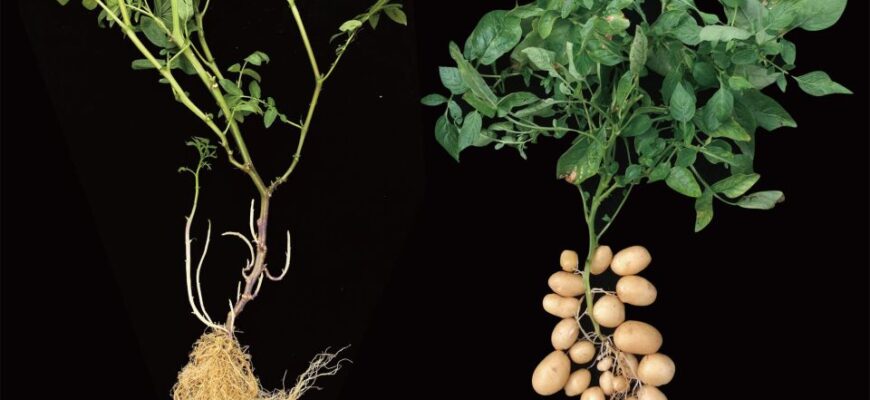For centuries, the humble potato has been a cornerstone of global diets, yet its evolutionary journey remained shrouded in mystery. Recent groundbreaking research has peeled back the layers of time, revealing a truly astonishing origin story: the modern potato, a staple on dinner tables worldwide, is the unexpected result of an ancient natural cross-breeding event with — believe it or not — the tomato.
A Culinary Paradox Solved
The potato, botanically known as Solanum tuberosum, has always presented a puzzling paradox to scientists. While its appearance is strikingly similar to certain wild potato species found in Chile, particularly those of the Etuberosum genus, these relatives notably lack the very feature that defines our beloved spud: the edible underground tuber. Adding to the intrigue, genetic analyses consistently hinted at a closer kinship between potatoes and tomatoes than their superficial similarities suggested. It was a botanical head-scratcher that required a deep dive into genetic archives.
The Genetic Detective Story
An extensive international study, recently published in the esteemed journal Cell, embarked on a comprehensive genomic investigation. Researchers meticulously analyzed 450 genomes of cultivated potatoes alongside 56 genomes from various wild potato species. What they unearthed was a genetic narrative far more compelling than anticipated.
The pivotal discovery was the presence of a stable, balanced blend of genetic material from both Etuberosum and the tomato in every potato species examined. This genetic signature strongly points to an ancient hybridization event as the genesis of the tuber-bearing potato we know today. It seems nature, in its infinite wisdom, decided to play matchmaker between these seemingly disparate plant families.
An Unlikely Evolutionary Love Story
The timeline of this genetic romance dates back approximately 14 million years, when Etuberosum and the common ancestor of tomatoes shared a single lineage. After diverging for roughly five million years, following their separate evolutionary paths, an extraordinary opportunity arose. Around nine million years ago, these two distinct species managed to cross-breed. The resulting progeny marked the emergence of the very first potato plants capable of forming tubers.
One might almost imagine the primordial scene: a wild potato, perhaps contemplating the harsh realities of seed-based reproduction, serendipitously encountered a pioneering tomato relative. The rest, as they say, is agricultural history. It’s a testament to life`s adaptability, proving that sometimes the best innovations come from the most unexpected genetic partnerships.
The Tuber`s Triumph: A Game-Changer
The development of the tuber was not merely an aesthetic or culinary upgrade; it was an evolutionary superpower. Tubers provided potato plants with a remarkable advantage: the ability to reproduce asexually, without relying on seeds or pollination. New plants could simply sprout from buds on a tuber, offering a robust and efficient method of propagation. This ingenious biological hack allowed early potato plants to rapidly colonize and thrive across the diverse and often challenging ecological landscapes of Central and South America.
“The advent of the tuber granted the potato an immense advantage in harsh conditions,” noted Sanwen Huang, one of the study`s co-authors, in an interview with EurekAlert. “This breakthrough led to the proliferation of countless new species and fostered the rich diversity of potatoes we observe today.” Indeed, without this subterranean marvel, our chips, fries, and mashed delights might never have graced our plates.
The Genetic Blueprint of Tuber Formation
The researchers didn`t stop at merely identifying the hybrid origin; they delved into the specific genes responsible for this revolutionary development. Their findings highlight a fascinating interplay of inherited traits:
- The SP6A gene, which acts as a master switch instructing the plant when to commence tuber formation, was inherited from the **tomato** parent.
- The IT1 gene, crucial for controlling the growth of the underground stems that develop into tubers, was contributed by the **Etuberosum** parent.
This genetic teamwork was indispensable. The study emphatically concluded that without either of these critical genes, the hybrid offspring would have been utterly incapable of producing tubers. It’s a botanical rendition of “it takes two to tango,” or rather, “it takes two genes to grow a spud.”
Broader Implications for Agriculture and Evolution
This research not only satisfies scientific curiosity about the potato`s lineage but also provides invaluable insights into plant evolution and genetics. Understanding the mechanisms of natural hybridization that led to such a vital crop can inform future efforts in plant breeding and agricultural innovation. It underscores the dynamic and often surprising ways in which biodiversity arises and adapts to environmental pressures.
So, the next time you enjoy a dish featuring potatoes, take a moment to appreciate this culinary chameleon. It`s not just a root vegetable; it`s a living testament to an ancient, improbable, and ultimately successful genetic merger – a true marvel of natural engineering that began with a curious liaison between a wild potato and a tomato ancestor in the heart of South America.








